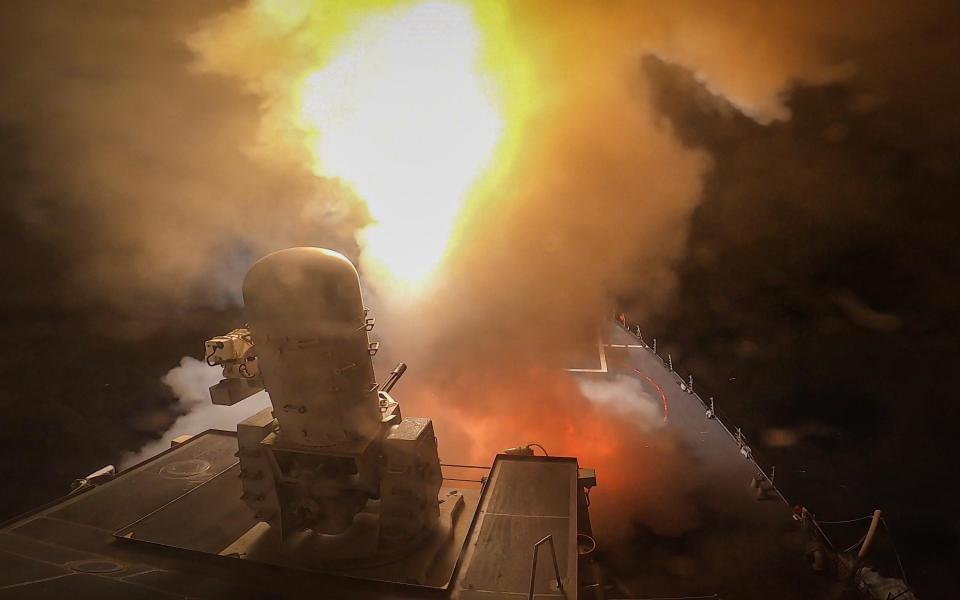The US Navy has a missile problem in the Red Sea
The US Navy has a missile problem. A shortage of its best SM-6 missiles – multipurpose weapons that can sink ships, hit targets on land and intercept aircraft and other missiles – could doom its fleet. Missiles are being expended at a high rate in the current Red Sea fighting against the Iranian-backed Houthis of Yemen. What good are the Navy’s 85 destroyers and cruisers if they can’t shoot?
A little industrial ingenuity could end the crisis, however. Defense firm Lockheed Martin is proposing to arm Navy ships with a missile that normally launches from land: the US Army’s Patriot.
The Patriot is a deadly accurate munition, as Ukrainian and Russians forces have learned. The hard way, in the Russians’ case. But its main advantage over the Navy’s best SM-6 missile is that Lockheed makes a lot of them.
On paper, the US fleet is a giant floating missile magazine. Each of 72 destroyers sails with as many as 96 vertical missile cells. A cruiser – the Navy has 13 of them – has 122 cells. Each cell can fire various weapons such as an SM-2 surface-to-air missile or a Tomahawk land-attack cruise missile. But the best weapon that fits in the so-called “vertical launch system” is the SM-6.
The 22-foot, 3,300-pound SM-6 is the Navy’s only omni-role missile. Thanks to its sensitive built-in radar, it works equally well against targets on the sea, on land and in the air out to a range of 150 miles or farther. It’s even able to offer a defense against incoming hypersonic weapons.

But the SM-6 is complex. For a decade now, the Navy has been paying Raytheon to build 125 of the missiles per year at a cost of slightly more than $4 million per missile; the fleet has around 600 in stock. The production rate should increase slightly in the coming years.
Even taking into account the fleet’s large arsenal of less-capable SM-2s, there’s a real danger it could get overwhelmed by enemy missiles, drones and warplanes during, say, a war with China over Taiwan.
Consider how many missiles, drones and planes Russia has hurled at Ukraine in the 23 months since the former widened its brutal war on the latter. The Ukrainian general staff claims its forces have, so far, shot down nearly 1,100 drones, nearly 500 manned aircraft and around 250 cruise missiles.
While the tally of aircraft shoot-downs almost certainly is an overcount, it’s plausible the other tallies are accurate. Since many air-defense missiles miss, Ukrainian batteries have had to fire thousands to shoot down those roughly 2,000 targets.
All that is to say, in a major war the US Navy should expect to contend with thousands of aerial targets – and should expect to fire thousands more missiles just to defend itself.
There’s almost no prospect of Raytheon ramping up production of SM-6s to, by itself, meet the fleet’s missile needs in the worst-case scenario: a war with China. What the Navy needs, in Lockheed’s estimation, is a cheaper missile. And one that’s already in mass-production.
The $4-million Patriot PAC-3 fits the bill, according to the firm. The 17-foot, 700-pound PAC-3 ranges just 50 miles – less than half the range of the SM-6 – but it’s got a highly accurate radar seeker and 180 tiny pulse motors that make it extremely maneuverable.
Ukraine has used older Patriots called “PAC-2s” to shoot down Russia’s much-hyped Kinzhal hypersonic missiles – and also to stage complex ambushes of manned warplanes. When the Ukrainians shot down one of the Russian air force’s rare A-50 radar planes over the Sea of Azov last month, they apparently used salvos of PAC-2s.
The PAC-3 “brings the Navy a great capability,” Lockheed official Tom Cavanaugh told Naval News last year. And as a bonus, Lockheed is already building 550 PAC-3s a year – and expects to increase that production rate over the next few years as the war in Ukraine fuels demand.
The PAC-3 might not be any cheaper than the SM-6, but it is available in larger numbers than the bigger missile.
The Navy seems to agree with Lockheed’s assessment of the land-based missile’s usefulness at sea. PAC-3s “would complement the current vertical-launch-system inventory of surface-to-air interceptors, giving the Navy greater missile inventory and expanding production opportunities,” a fleet spokesperson told Breaking Defense.
The Navy and Lockheed have agreed to launch at least one PAC-3 from a destroyer’s missile cell sometime this spring or summer. If it works, a production decision could follow.
If it doesn’t work, or if the Navy decides it can’t afford to add another budget line-item for missile production, it risks leaving the fleet defenseless in a major war. Yes, in an emergency the Navy could throw billions of dollars at Raytheon and other missile-makers and expand production of SM-6s, SM-2s and other munitions.
But even when money is no issue, it takes time to expand the high-tech facilities that assemble missiles and train the skilled technicians who do that actual work. If the Navy waits until it’s in a major war before it adds missiles, it might discover it’s too late.

